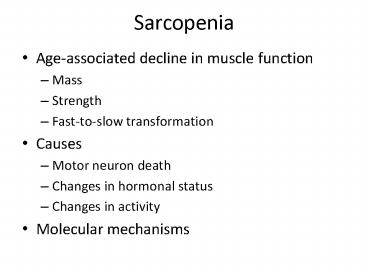Sarcopenia - PowerPoint PPT Presentation
1 / 22
Title:
Sarcopenia
Description:
Sarcopenia Age-associated decline in muscle function Mass Strength Fast-to-slow transformation Causes Motor neuron death Changes in hormonal status Changes in activity – PowerPoint PPT presentation
Number of Views:2615
Avg rating:3.0/5.0
Title: Sarcopenia
1
Sarcopenia
- Age-associated decline in muscle function
- Mass
- Strength
- Fast-to-slow transformation
- Causes
- Motor neuron death
- Changes in hormonal status
- Changes in activity
- Molecular mechanisms
2
Sarcopenia phenomenology
- Atrophy associated with aging
- 1-2 annual loss of strength beginning age 40-50
- 0.5-1.5 annual loss of specific tension
- Slowing
- Fast?slow MHC
- 0.5 annual loss of aerobic capacity
Lexell al., 1988
Elite weightlifters
Untrained
Pearson al., 2002
3
Cachexia
- Muscle wasting secondary to pathology
- Cancer
- HIV/AIDS
- Usually without change in fat mass
- Distinct from starvation/anorexia
- Strong predictor of mortality
- Chronic inflammation
- Insulin resistance
4
Sacopenia causes
- Hormonal
- Testosterone (HRT little change in strength or
mass) - GH/IGF-1 estrogen
- Lifestyle
- Young people are hyperactive mate seeking and
reproduction - Old people are hypoactive job and child
maturation - Neural
- Motor neuron population declines parallel muscle
- Capacity for neural remodeling declines
Lamberts al., 1997
5
Lifestyle hypothesis
- Social structure encourages disuse
- Animal sarcopenia
- Mice, rats, cats, dogs
- Voluntary activity declines after mid-life
- Muscle mass declines after mid-life
Rat muscle mass vs age Lushaj al., 2008
Rat voluntary run distance (Holloszy al., 1985)
6
Non-mammalian sarcopenia
- Worms (C elegans)
- Flies (Drosophila)
- Note No satellite cells
- Mitochondrial swelling and dysfunction
- Myofibrillar degeneration
C elegans muscle (g 2 d young h 18 d
old) Herndon al., 2002
Drosophila flight muscle 7 days (L) 86 days
(R) Takahashi al., 1970
7
Insulin/IGF-1 signaling
- Content increases
- IGF-1 (mRNA)
- IGF-1 receptor activation
- Downstream signaling declines
- IRS1 content
- Active IRS-1
- Protein synthesis
- 20-30 lower at 70 y.o. vs 30
- Resistance exercisesimilar
Haddad Adams, 2006
8
Atrogene signaling
- Little change in MuRF/Mafbx
- Increase Akt
- akt generally pro-growthso its elevation may
revealineffective attempt to maintain mass - Reduced autophagy
Gaugler al., 2011
9
Response to exercise
- 8X10 _at_ 70 1RM
- Akt-mTOR similar peak, but condensed
- ERK attenuated
- Protein synth well predictedby signaling
- Equivalence of loading?
Fry al., 2011 (humans)
10
Response to overload
mTOR
- Synergist ablation
- Attenuated signaling
- Low, but consistent hypertrophy
- Aged animals also much less AMPstress
- SA may be weak stimulus
p70S6k
4EBP-1
Thomson Gordon, 2006 (rats)
11
Mitochondria
- Decline in mitochondrial DNA
- Increase in DNA oxidative modification
- Decline in Mt protein
- Decline in Mt protein activity
Citrate Synthase
µM/min/mg Mt protein
Oxidative modification
ATP Synthesis
µM/min/mg Mt protein
Short al., 2005
12
Oxidative stress hypothesis
- Mitochondrial dysfunction increases oxidative
damage, and degeneration/apoptosis - ROS protection
- SOD1 (Cu-Zn, cytosolic)
- SOD2 (Mn, mitochondrial)
13
Drosophila
- Global SOD1 k/o shortens lifespan
- Rescued by global SOD1 transgene
- Rescued by motorneuron-specific SOD1 tg
- MN SOD1 increases lifespan in WT
- SOD2-/- neonatal lethal
SOD1-/- SOD1-/- 1tg SOD1-/- 2tg
Reveillaud al., 1994
Parks al., 1998
14
Mouse
- SOD2-/- neonatal lethal
- SOD1-/- mouse have reduced lifespan
- Motorneuron deficiency
- NMJ failure
Elchuri al., 2005
Flood al., 1999
15
Muscle-specific knockouts
- Conditional MnSOD-/- have normal sarcopenia (ie
not accelerated) - Conditional Cu-Zn SOD -/-
- Exercise intolerance, atrophy
- Lifespan?
- Transgenic overexpression of SOD1 improves
ischemia-reperfusion recovery
16
Chronic exercise
- Exercise increases mitochondria, mitochondrial
function, and oxidant scavenging - Ad lib wheel running
- 2-7 miles/day
- Stop at 4-6 months?8 food restriction
- Pair-fed sedentary
- Pair-weight sedentary (25 CR)
Sedentary Runners Pair-fed sedentary Pair-weight
sedentary
Holloszy al., 1985
17
Born runners
- Mice bred 30 generations for wheel running
- No survival benefit of exercise
- Missing group C-
- Running is good for you, only if you dont like it
Control strain Runners
Control strain, with wheel Runners, with
wheel Runners, no wheel
Vaanholt al., 2010
18
Motorneuron hypothesis
- Neural degeneration results in denervation
atrophy - Motor unit number estimation (EMG)
- Find single motor unit amplitude (CMAP)
- Divide total EMGamplitude by CMAP
Motor unit number in Young, Old, and old Master
Runners (Power al 2012)
Motor unit number vs age in humans (Lexell, 1985)
19
MU decrease in animals
- Retrograde label
- Count cells
- Size discriminates among MN classes
- a-, but not g-MN decrease w/age
- Similar timing as muscle atrophy
- MN pools not preserved by FO
MN pool in rat MG (Hashizume al., 1988)
20
Muscle-motor neuron interaction
- SOD1G93A mouse
- Dysfunctional SOD1
- ALS model
- mIGF-1
- Muscle specific transgene
- Substantially improves survival
- Maintains MN
Dobrowolny al., 2005
21
Motor neuron survival
- Neurons, esp MN, seem highly sensitive to ROS
- Failure of ROS-protection may kill MN
- Denervation-induced atrophy
- Muscle-derived factors may sustain nerve
- IGF-1
- Neurotrophin
- Exercise provides minimal MN protection
22
Summary
- Humans begin to fall apart sometime around 40
years - Activity hypothesis
- Oxidative stress hypothesis
- Neural degeneration hypothesis
- Parallel declines in strength, activity, muscle
mass, MN population - Reduced protein synthesis
- Sustained or reduced protein degradation
- Hyperactive pro-growth signaling
- Overload is a countermeasure not a cure
- Reduced sensitivity to hypertrophic stimuli
- Oxidative stress aggravates MN degeneration































